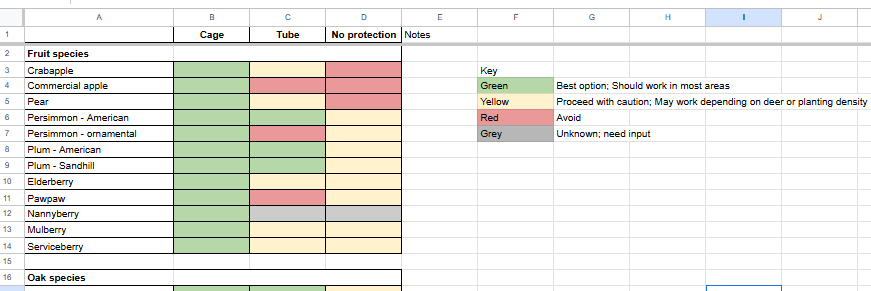Hoytvectrix
5 year old buck +
I started working on a document that I think will be a helpful reference for those looking to improve their habitat. The document is and will always be free once I publish the sharing link here. Currently, I have a reference chart for protecting trees by tree species and method, a habitat calendar template, and a hunting chores calendar. I need some help though. Please look over this list of tree species and comment below with others that need to be added. If you think they could be grouped in better way, share that as well.
Obviously, much of this will be a matter of opinion. This document will still serve as a template for people to create their own if they want.
Here is what the tree protection chart looks like currently:

Here is a list of the tree species and how they are broken down. Please look this over and let me know what is missing or if you think there might be a better way of organizing things:
Fruit species
Crabapple
Commercial apple
Pear
Persimmon - American
Persimmon - ornamental
Plum - American
Plum - Sandhill
Elderberry
Pawpaw
Nannyberry
Mulberry
Serviceberry
Oak species
White oak
Red oak
Swamp white oak
Concordia oak
Shingle oak
Sawtooth oak
Black oak
Bur oak
Chinkapin oak
Swamp chestnut oak
Nut species
Hazelnut - American
Hazelnut - beaked
Hazelnut - hybrid
Chinese/hyrbid chestnut
American chestnut
Ozark Chinquapin chestnut
Alleghany Chinquapin chestnut
Black walnut
Shagbark hickory
Pecan
Evergreen species
E. red cedar
White cedar
White pine
Norway spruce
Flowering tree species
Flowering dogwood
Red osier dogwood
Smooth / rough dogwood
Gray dogwood
E. redbud
Smooth sumac
Buttonbush
Carolina buckthorn
Other/Cover tree species
Hybrid poplar
Sandbar willow
Ninebark
Osage orange
Obviously, much of this will be a matter of opinion. This document will still serve as a template for people to create their own if they want.
Here is what the tree protection chart looks like currently:

Here is a list of the tree species and how they are broken down. Please look this over and let me know what is missing or if you think there might be a better way of organizing things:
Fruit species
Crabapple
Commercial apple
Pear
Persimmon - American
Persimmon - ornamental
Plum - American
Plum - Sandhill
Elderberry
Pawpaw
Nannyberry
Mulberry
Serviceberry
Oak species
White oak
Red oak
Swamp white oak
Concordia oak
Shingle oak
Sawtooth oak
Black oak
Bur oak
Chinkapin oak
Swamp chestnut oak
Nut species
Hazelnut - American
Hazelnut - beaked
Hazelnut - hybrid
Chinese/hyrbid chestnut
American chestnut
Ozark Chinquapin chestnut
Alleghany Chinquapin chestnut
Black walnut
Shagbark hickory
Pecan
Evergreen species
E. red cedar
White cedar
White pine
Norway spruce
Flowering tree species
Flowering dogwood
Red osier dogwood
Smooth / rough dogwood
Gray dogwood
E. redbud
Smooth sumac
Buttonbush
Carolina buckthorn
Other/Cover tree species
Hybrid poplar
Sandbar willow
Ninebark
Osage orange

